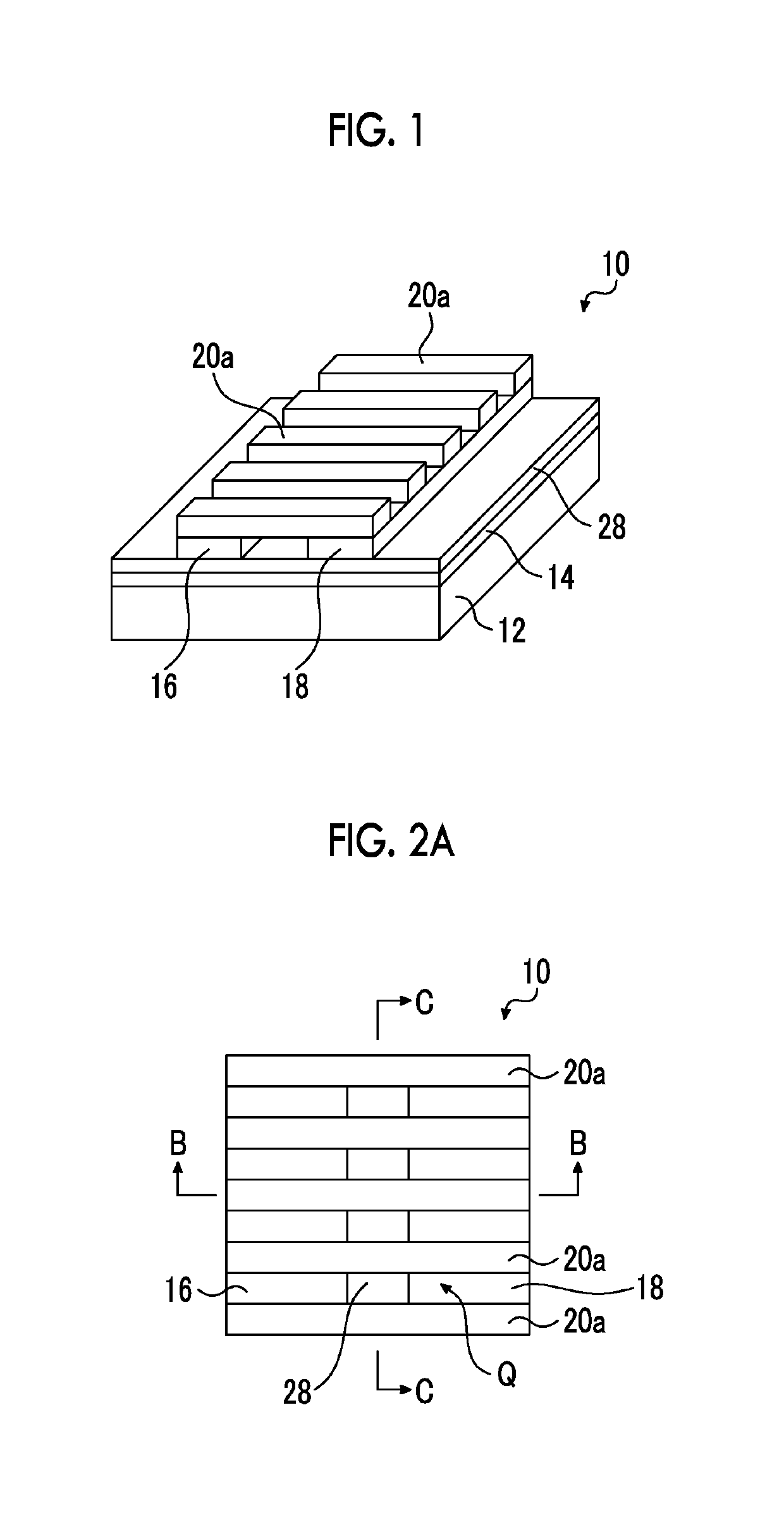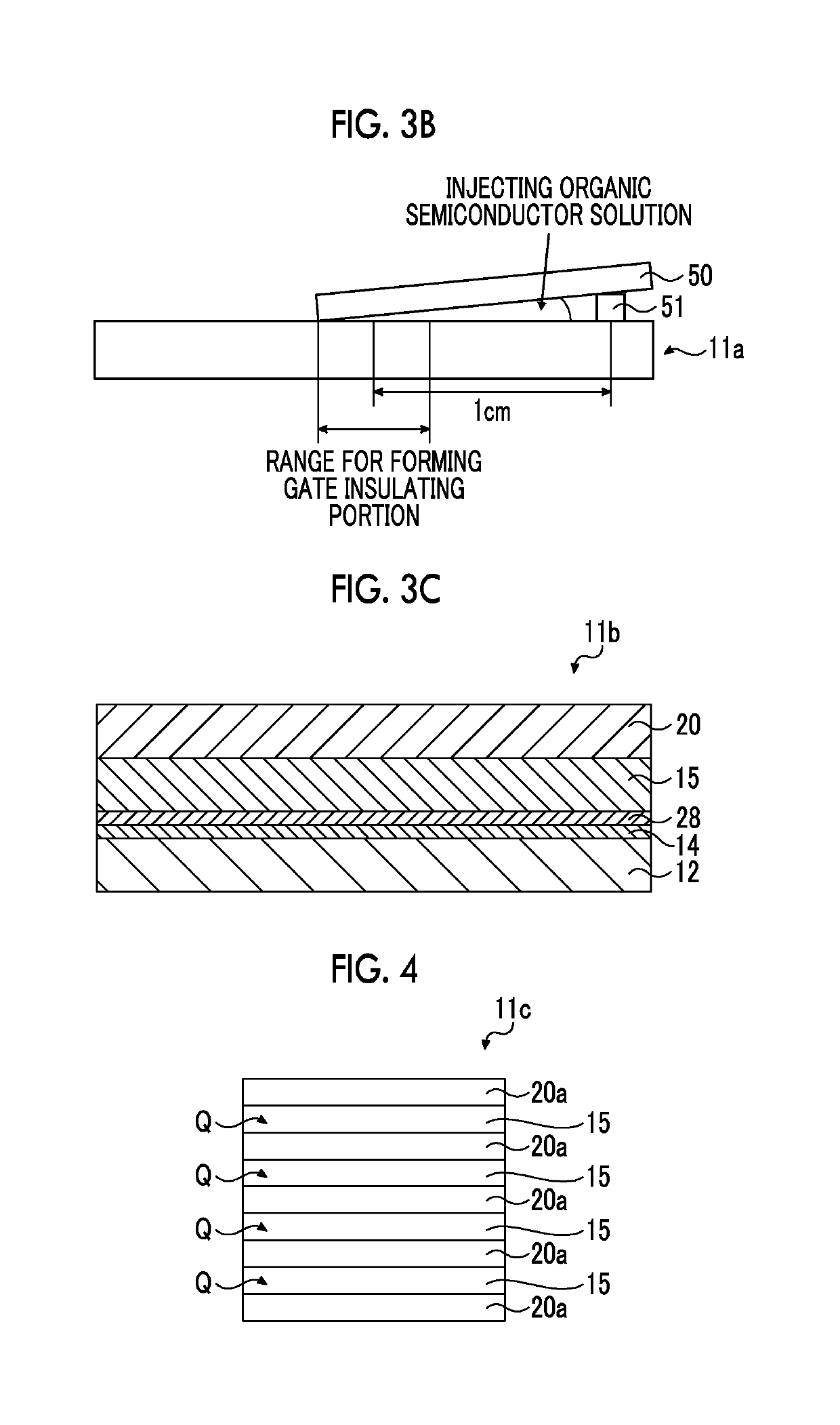Transistor and manufacturing method of transistor
a manufacturing method and transistor technology, applied in the direction of transistors, semiconductor devices, electrical apparatus, etc., can solve the problems of poor product quality, difficult microfabrication, and inability to achieve high alignment accuracy, and achieve high electrical connection reliability, good transistor characteristics, and high productivity
- Summary
- Abstract
- Description
- Claims
- Application Information
AI Technical Summary
Benefits of technology
Problems solved by technology
Method used
Image
Examples
example 1
[0174]
[0175](Preparation Step)
[0176]Alkali-free glass having a thickness of 0.7 mm and a size of 50 mm×50 mm (EAGLE XG, manufactured by Corning Incorporated) was used as the substrate 12.
[0177]Chrome (Cr: 0.01 μm thickness) and silver (Ag: 0.04 μm thickness) were sequentially vacuum-vapor deposited on the alkali-free glass substrate 12 by using a general vacuum vapor deposition apparatus to form the gate electrode layer 14.
[0178]Next, an aluminum oxide (AlOx: 0.2 μm thickness) film was formed on the Gate electrode layer 14 as the solid insulating layer 28 by high frequency magnetron sputtering using a general high frequency magnetron sputtering apparatus.
[0179]Further, a gold film (Au: 1 μm thickness) was formed on the solid insulating layer 28 as the support precursor layer 15 by using a general sputtering apparatus to prepare the laminate 11a.
[0180](Semiconductor Layer Forming Step)
[0181]A semiconductor layer (1 μm thickness) was formed on the support precursor layer 15 of the pr...
example 2
[0195]A transistor was prepared in the same manner as in Example 1 except that the etching step in the support forming step was changed.
[0196]Specifically, the laminate 11d was immersed in the Au etching solution (AURUM-304, manufactured by KANTO CHEMICAL CO., INC.) for 5 minutes. Next, the laminate was immersed in an aqueous solution of tetramethyl ammonium hydroxide (TMAH: 2.38%) for 2 hours and then washed by being immersed in pure water for half a day. The laminate was further immersed in a hydrofluoroether-alcohol mixed solvent (Novec 71IPA, manufactured by 3M Japan Limited) for 10 minutes and then was dried naturally. Furthermore, vacuum drying was performed for a day.
[0197]As a result, the support precursor layer 15 and the solid insulating layer 28 corresponding to the region between the two etching protective layers 30a and 30b were removed and thus the transistor 40 as shown in FIG. 7 was prepared. That is, the insulating layer removing step was provided.
example 3
[0198]A transistor was prepared in the same manner as in Example 1 except that in the opening portion forming step, the shape of the opening portion Q to be formed was changed to a shape shown in FIG. 8. In this case, the formation pattern of the opening portions Q is set to Pattern B.
[0199]The number of opening portions Q was set to 10 and the size of the opening portion was set to 20 μm×100 μm. In addition, the outer peripheral portion of the semiconductor layer 20f was also removed by irradiation with a laser and the size of the entire semiconductor layer 20f was set to a width of 1 mm×a depth of 0.4 mm.
PUM
 Login to View More
Login to View More Abstract
Description
Claims
Application Information
 Login to View More
Login to View More - R&D
- Intellectual Property
- Life Sciences
- Materials
- Tech Scout
- Unparalleled Data Quality
- Higher Quality Content
- 60% Fewer Hallucinations
Browse by: Latest US Patents, China's latest patents, Technical Efficacy Thesaurus, Application Domain, Technology Topic, Popular Technical Reports.
© 2025 PatSnap. All rights reserved.Legal|Privacy policy|Modern Slavery Act Transparency Statement|Sitemap|About US| Contact US: help@patsnap.com



